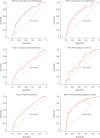Association of Clinical Characteristics With Familial Hypercholesterolaemia Variants in a Lipid Clinic Setting: A Case-Control Study
- PMID: 38299170
- PMCID: PMC10825568
- DOI: 10.12997/jla.2024.13.1.29
Association of Clinical Characteristics With Familial Hypercholesterolaemia Variants in a Lipid Clinic Setting: A Case-Control Study
Abstract
Objective: Familial hypercholesterolaemia (FH) variant positive subjects have over double the cardiovascular risk of low-density-lipoprotein-cholesterol (LDL-C) matched controls. It is desirable to optimise FH variant detection.
Methods: We identified 213 subjects with FH gene panel reports (LDLR, APOB, PCSK9, and APOE) based on total cholesterol >310 mg/dL; excluding triglycerides >400 mg/dL, cascade screening, and patients without pre-treatment LDL-C recorded. Demographic, clinical and lipid parameters were recorded.
Results: A 31/213 (14.6%) patients had pathogenic or likely pathogenic FH variants. 10/213 (4.7%) had variants of uncertain significance. Compared with patients without FH variants, patients with FH variants were younger (median age, 39 years vs. 48 years), had more tendon xanthomata (25.0% vs. 11.4%), greater proportion of first degree relatives with total cholesterol >95th percentile (40.6% vs. 16.5%), higher LDL-C (median, 271 mg/dL vs. 236 mg/dL), and lower triglycerides (median, 115 mg/dL vs. 159 mg/dL). The Besseling et al. model (c-statistic 0.798) improved FH variant discrimination over Friedewald LDL-C (c-statistic 0.724), however, Dutch Lipid Clinic Network Score (DLCNS) did not (c-statistic 0.665). Sampson LDL-C (c-statistic 0.734) had similar discrimination to Friedewald.
Conclusion: Although tendon xanthomata and first degree relatives with high total cholesterol >95th percentile were associated with FH variants, DLCNS or Simon Broome criteria did not improve FH detection over LDL-C. Sampson LDL-C did not significantly improve discrimination over Friedewald. Although lower triglycerides and younger age of presentation are positively associated with presence of FH variants, this information is not commonly used in FH detection algorithms apart from Besseling et al.
Keywords: APOB protein, human; Besseling; Dutch Lipid Clinic Network Score; Hyperlipoproteinemia type II; LDLR protein, human; PCSK9 protein, human.
Copyright © 2024 The Korean Society of Lipid and Atherosclerosis.
Conflict of interest statement
Conflict of Interest: The authors have no conflicts of interest to declare.
Figures


References
-
- Besseling J, Reitsma JB, Gaudet D, Brisson D, Kastelein JJ, Hovingh GK, et al. Selection of individuals for genetic testing for familial hypercholesterolaemia: development and external validation of a prediction model for the presence of a mutation causing familial hypercholesterolaemia. Eur Heart J. 2017;38:565–573. - PubMed
-
- Huijgen R, Hutten BA, Kindt I, Vissers MN, Kastelein JJ. Discriminative ability of LDL-cholesterol to identify patients with familial hypercholesterolemia: a cross-sectional study in 26,406 individuals tested for genetic FH. Circ Cardiovasc Genet. 2012;5:354–359. - PubMed
-
- World Health Organization. Familial hypercholesterolaemia (FH): report of a second WHO consultation, Geneva, 4 September 1998. Geneva: World Health Organization; 1999.
LinkOut - more resources
Full Text Sources
Miscellaneous

